Make hay when the sun shines
This week: Make hay when the sun shines; Central heating complete; Tongue in cheek; Ooh, I felt that;
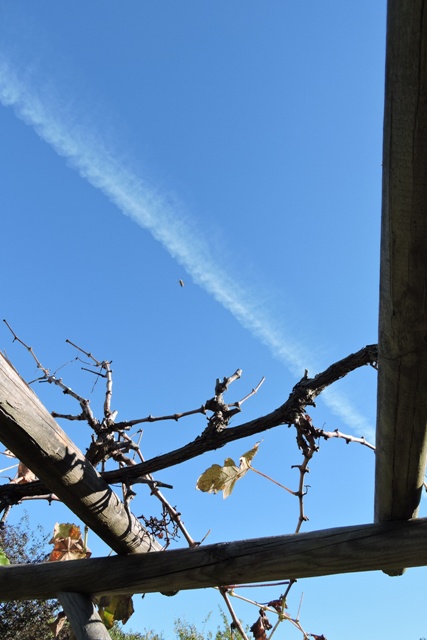
We have had a good week of weather this week, some occasional high cloud but mainly bright warm autumn sunshine and clear skies.
The sun is now behind the hill at the back of my home from 14:00, although it will shine on the rest of Dol for another two hours.
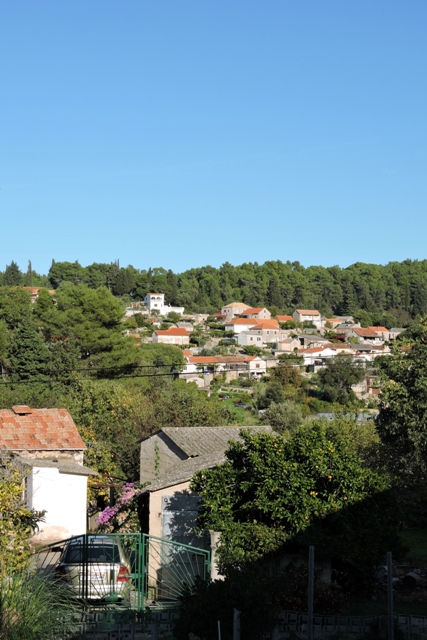
It is a reminder of the short winter days to come.

As daylight turns to dusk, with just a light katabatic wind barely moving the remaining leaves on the trees, the smell of wood smoke fills the air, as my neighbours crank up their heating stoves for the evening.
I’ve not made the progress outside that I would have liked to have done this week, but have achieved some objectives. Perhaps next week instead then….
Meanwhile I still have some autumn flowers to brighten every day.

But as more and more leaves change colour and fall, the ground is being slowly covered. I’m collecting all that I can to make leaf mould.
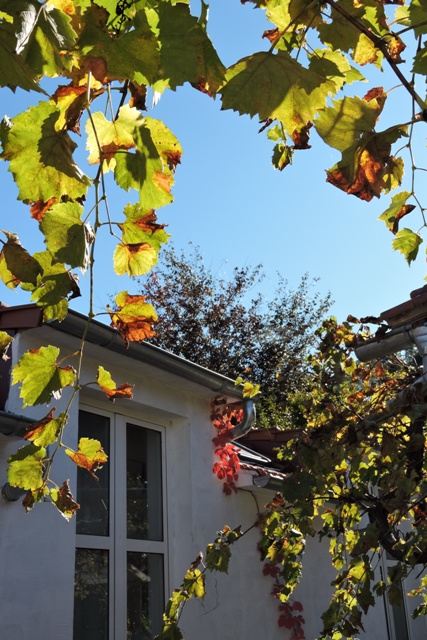
Make hay when the sun shines
With a forecast for a nice week of warm weather, I planned for a week of garden work.
I wasn’t actually thinking of making hay, although I had wondered about cutting the Lucerne back for one last time this year. It was more about being outside and doing jobs while the weather is good.
Several of my citrus trees are covered in flowers, which is normal for citrus at this time of year. But it also means that I was thinking about protecting them, just in case we get a cold winter Bura wind sweeping in from the north.
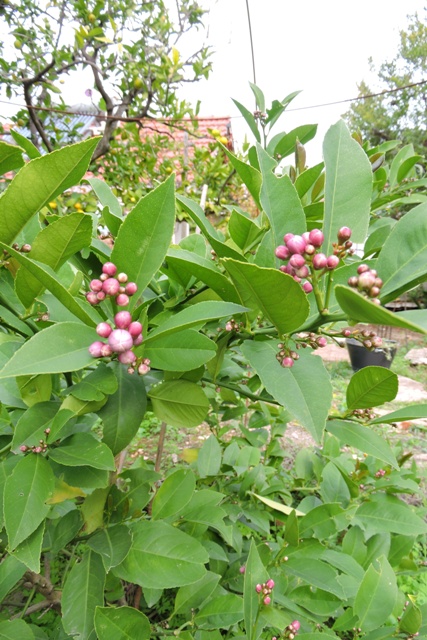
All but one of the citrus have steel rebar frames around them. The last one, a Meyer Lemon, had been left in case the builders had to use the summer kitchen roof to bring concrete in. If there had been a frame, I would have had to remove it.
They didn’t, and with the workshop finished, I can now erect the frame around this young tree. It has several lemons on it, slowly ripening so I had to be careful.
I removed all the sprouting weeds then after checking my plan of where the irrigation pipes run, used the long wall drill to make holes in the soil 80cm deep, to take the rebar.
The last time I was drilling for the rebar, it was summer and the clay soil had set like concrete. With the recent rains, I had no problem making the four holes.
Meyer lemons are compact trees, seldom growing more than two meters tall or with a spread greater than two meters, which is why I planted it close to where the steps up to the summer kitchen roof are.
It’s not likely to grow and spread enough to cause access problems.
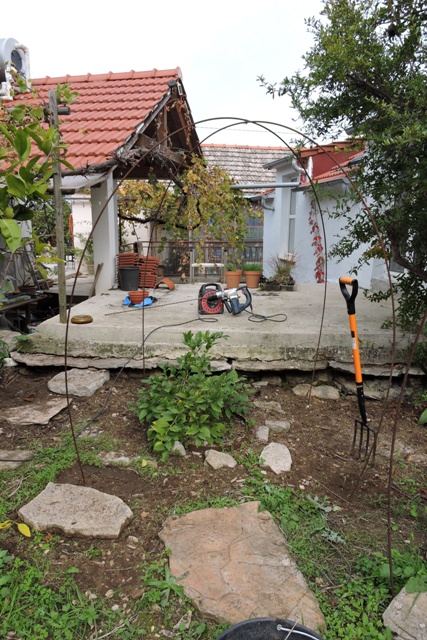
The dimensions for the wire cage is an arc of one meter radius from the centre of the tree, a height of two meters and a hoop circumference of six meters. I need to get some of the thin rebar now to make the hoop.
With the last wire frame in place, I then then did maintenance on all the other wire frames. I started by replacing bare steel wire with plastic coated wire and making sure the hoops which will hold the screening material are all level.

With the work finished, I am ready to hang screening material as soon as colder weather threatens. In the meantime, they are still getting sunshine (for a few more weeks) so I am leaving the trees uncovered.
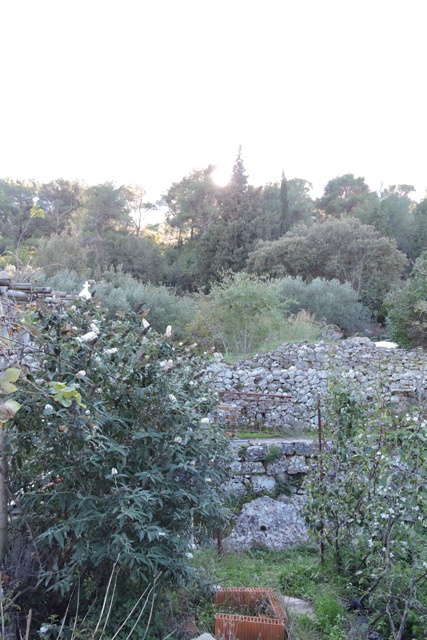
What I did find was that one of my grapefruit trees has its first fruit. It has taken five years to get to an age when it will produce fruit.

Central heating complete
This week my neighbours have all lit their wood stoves for the first time this winter season.
It has not been especially cold for me, but then I have increased the insulation throughout my home as I have done the renovations. The old houses round about have no insulation or double glazing to speak of.
After a hunt I found the remains of a bottle of Fernox central heating corrosion inhibitor that I had used when I installed the system, so I poured it into the pipes and connected everything up.
I did eventually and after several prompts get an answer from Forol, the Zagreb company, about the antifreeze I was sold locally (Week 42 blog) telling me that it is for engine radiators, not central heating.
I needed to do a bit of work in the small konoba where the pump is located, under my wood stove, to build a new support shelf for the UPS which runs the electric pump. The one it had been on is now in the new workshop.
I was also thinking about the system which operates the electric pump.
From the UPS, power runs up through the concrete floor to a contact thermostatic switch behind the fire which is attached to the hot water outlet pipe. As soon as the water pipe temperature reaches 40ºC, this thermostatic switch turns power on and the electric pump begins to circulate water around the system.
When you break into a central heating system, even an “open system” like mine, then there will be water loss. In the spring when the building work was ongoing, I had to disconnect the hot water links between the buildings and then install new pipework to connect everything up.
I closed all the radiators first, so they retained the water inside, and shut the valves on the pipes leading to the fire, so throughout the summer, the water has remained inside. However most of the water was emptied from the pipes.
Knowing that there would be a lot of air in the system and I didn’t want to light the fire just to get the pump working, I added an extra switched electrical circuit to the pump, so I can turn it on and off even when the fire is unlit.
Once I had everything connected, I turned the pump on and could hear the gurgling as the water and air mixture moved around the pipes. When I built the new heating system, I included a filling point, so connected it up to a tap and added water.
I then progressively went round and bled any air from the various radiators. There were no leaks and the system is completely charged, so it is ready for when I need to light the fire.
As hot water expands, there will still be some small air locks that I will have to remove, but nothing like the amount that I released this week.
This is another of those “little” jobs that I can now tick off my ‘to do’ list.
Tongue in cheek
Sometimes you see something online which strikes a chord.
This week it was the arrest of a Jesuit Priest, found hiding in a Priest Hole in an English stately home, in possession of prohibited items.
The location in question, Hindlip Hall in the County of Worcestershire. This is a location I know well as it is the headquarters of the West Mercia Police and somewhere I visited regularly.
It is almost geographically central in the UK, has the M5 motorway running past the door, so was a good place for meetings and briefings.
The prohibited article was a Crucifix.
At this point I should say that the arrest was in November 1605. Father Edward Oldcorne was later hanged, drawn and quartered (the statutory penalty at the time for the offence of High Treason).
This Medieval punishment was only removed from the Statute Books in England in 1870.
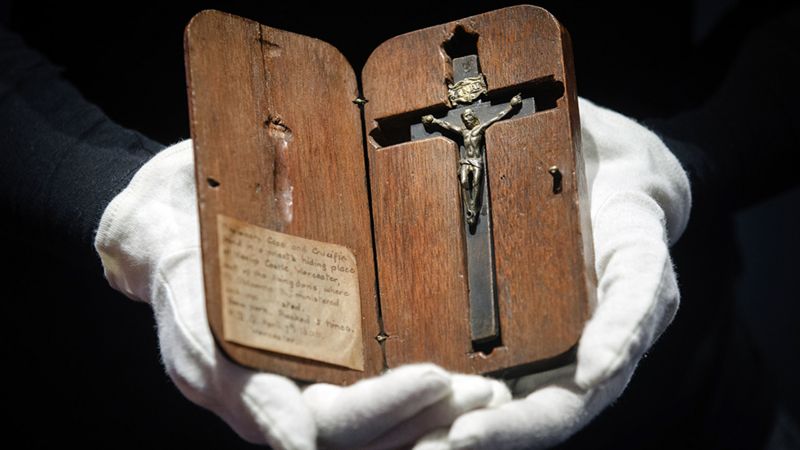
This week the said Crucifix has gone on display at the Bar Convent school in York.
I asked colleagues, tongue in cheek, in a local history group whether anyone remembers who the arresting officer was, and if the Priest Hole still existed – in the Chief Constable’s office perhaps?
The 5th of November, in normal, non-COVID times is Bonfire Night, the one night in the year when there are very large firework displays and a “guy” is burnt on bonfires in every corner of the UK.
I must also make formal disclosure here of a personal interest in the story. Being born and brought up in York I attended the same school as Edward Oldcorne, and Guido Fawkes.
Fawkes was one of the plotters intending to blow up the English Parliament and assonate the King. On 5th November 1605 Londoners were encouraged to light bonfires to celebrate the discovery of the Gunpowder Plot and the King being saved, an event continued to this day.
At school it was always a source of annoyance to me that we were prevented from celebrating with fireworks, like the rest of the country, because it was a celebration of the death of a former pupil.
I should add that Fawkes and Oldcorne were students there just a little before my time at school, but even so they had not been forgotten.
Around the world, the use of Guy Fawkes masks is seen as a sign of protest. Although masks have long featured in the November 5th celebrations, it was the use of the mask in the film V for Vendetta that greatly expanded the use of the symbol as a form of political protest.
Just yesterday in London, demonstrators against the English lockdown for COVID-19 were arrested wearing the mask.

Ooh, I felt that
On Sunday afternoon, just after 3pm I was sitting at the computer, with a mug of coffee, when there was the unmistakable rattle of windows, doors and old roof timbers as another earthquake rippled through the island’s bedrock.
It quickly showed up on the European earthquake monitoring site, as a 4.6 magnitude, 10 kilometres deep and 100 kilometres north west of Split.
I filled in an earthquake report. There was no damage and if I hadn’t been sitting in a quiet room, I’d probably never have felt it at all.
On Thursday, I decided that I would cut some more wood for my wood burning stove. With the sun well into the sky on a bright clear day, I had an early coffee and got ready.
Going into the workshop to get my small chain saw, I bent over to pick up a screwdriver that I had knocked onto the floor. As I straightened up, I felt a bit of a muscle twinge in my left lower back, so thought I would not do too much so as not to make it worse.
There are several tracks up the hillside behind my home, so with camera over my shoulder and the small chainsaw in my hand, I took the one which leads to where my neighbour said I could cut any timber I wanted.
Cutting wood means you have to bend over and each time I did, I could feel the muscle in my back aching a little more.
So after cutting just a very few small shrubs to make a path to get to one of the dead trees, I decided I would give up. It was very definitely one of those “Ooh, I can feel that” moments.

The old Cyprus is still standing, so when it rains, the firewood will not get wet and I can cut it another day
After tea on Thursday, I got the electric blanket out of the store and went to bed with it on full to apply a little heat.
On Friday morning I could still definitely feel some pain so spent the day doing admin tasks. I don’t want to get a bad back this early, with a lot of work to do this winter.
I’m not one for taking painkillers. Pain is the body’s way of telling you something is wrong, so masking it and carrying on is not a good idea.
So as Saturday afternoon rolls round again, after another week has flown past, I have lost a couple of days when I could have been working outside, but I’m being sensible, honestly!
I’ll try and do better next week. NCG
One Response
John Bailey
Hope you are soon feeling your old self. Take it easy for a few days . A bad back can be very debilitating.